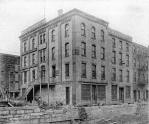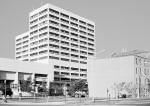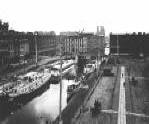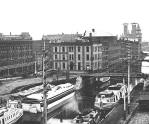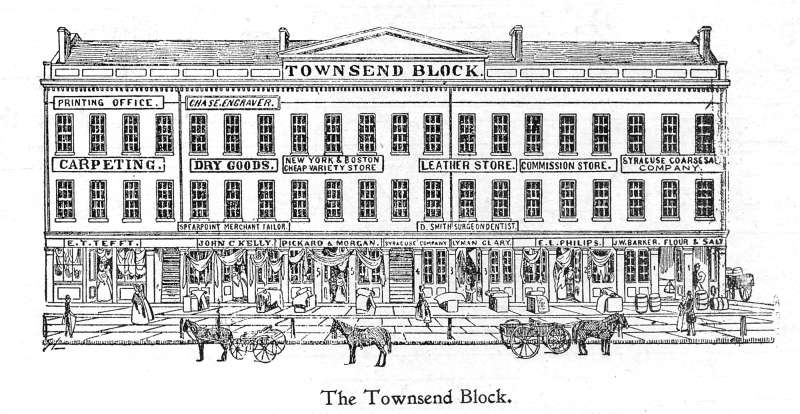|
The "Jerry Rescue" Building |
|
West side of Clinton Square between Water and Erie"Resolved: That we rejoice that the City of Syracuse -- the anti-slavery city of Syracuse -- the city of anti-slavery conventions, our beloved and glorious city of Syracuse -- still remains undisgraced by the fulfillment of the satanic prediction of the satanic Daniel Webster."
In September of 1850 Congress passed the Fugitive Slave Law providing stiff penalties for any person who aided fugitives in their escape to freedom (New York State was among the first states to abolished slavery in 1827). A few weeks later, on October 4th, more than 500 citizens of Syracuse, including Mayor Alfred H. Hovey, met to plan their response. At this meeting they formed the Vigilance Committee made up of leading citizens of both races who pledged "their lives, their fortunes, and their sacred honor" that no person would be taken from Syracuse and returned to slavery. In May of 1851, U.S. Secretary of State Daniel Webster stood on a balcony overlooking City Hall and pointedly threatened the defiant little city. Webster labeled efforts to block execution of the Fugitive Slave Law "treason, treason, TREASON," and he pledged that the law "will be executed in all the great cities – here in Syracuse – in the midst of the next Antislavery Convention, if the occasion shall arise." Just five months later the occasion did arise. (Continued Below)

About 1880 The "Jerry Rescue Block" -- all three of the buildings clustered together here are now gone (notice the canal wall in the foreground). On October 1st of 1851, the anti-slavery Liberty Party opened its New York State Convention in Syracuse. At about noon on that same day, William "Jerry" Henry was at his usual workplace, engaged in his trade as barrel maker. A large contingent of law enforcement officers descended on Henry's workplace including federal marshals from Rochester, Auburn, Syracuse, and Canandaigua, as well as local police officers. At first Henry was told that the charge was theft; once he was safely in manacles the officers told him he was being arrested under the Fugitive Slave Law. After putting up considerable resistance, he was subdued and taken away.
When word of the arrest reached the convention, church bells began to ring and a crowd gathered at Commissioner Sabine's office in the Townsend Block (now the Arcade building) where Henry was to be arraigned. The crowd rushed the building, managing to get Henry as far as the street outside before he was recaptured and taken back. The arraignment was then put off until evening when a larger room in the adjacent police station (the "Jerry Rescue" building) could be secured. A few hours later a crowd of more than 2,000 gathered at the new location and, using a battering ram, broke down the door. Deputy marshals fired shots out the window but it soon became clear the crowd was too large and determined to be resisted. One deputy marshal broke his arm jumping from a second story window. Henry was taken away by the crowd and hidden for several days in the home of a local butcher where he could recover from his injuries. He was then taken by wagon to Oswego where he crossed into Canada. The day following the rescue, anti-slavery leader and future U.S. Congressman Gerrit Smith introduced a resolution at the Liberty Party convention referencing Daniel Webster's prediction of an arrest and referring to the Secretary of State as "that base and infamous enemy of the human race." Smith therefore resolved, "That we rejoice that the City of Syracuse – the anti-slavery city of Syracuse – the city of anti-slavery conventions, our beloved and glorious city of Syracuse – still remains undisgraced by the fulfillment of the satanic prediction of the satanic Daniel Webster." The resolution passed easily. Nineteen Federal indictments were handed down for those involved in the rescue. Those indicted included US Senator, and former governor, William H. Seward. When the prosecution objected to Gerrit Smith – a non-lawyer – appearing on behalf of the defense, the Court of Appeals immediately issued an order admitting Smith to the bar. The trials dragged out for two years. Only one of the indictments ended in conviction and that man died while waiting for his case to be heard on appeal. Smith and others turned the tables by obtaining an indictment against Marshal Allen for kidnapping. Although Allen was ultimately acquitted, Smith and his compatriots used the trial to argue against the constitutionality of the Fugitive Slave Law (the text of Smith's argument before the court is in the Syracuse University Archives). Commemoration of the "Jerry Rescue" became an annual event in Syracuse with Gerrit Smith delivering addresses every year from 1852 to 1858 (some of these addresses are also in the Syracuse University Collection). In 1858 Thomas Wentworth Higgison and the famous abolitionist Frederick Douglass also addressed the gathering. In 1859 Gerrit Smith sent a letter to the chairman of the Jerry Rescue Committee declining to participate in that year's event and expressing his frustration with the abolitionist movement in general. In the letter, Smith predicted anti-slavery insurrections would occur "...any year, any month, any day." Six weeks later John Brown led a raid on the federal arsenal at Harper's Ferry. He intended to use the weapons he captured to establish a base in the southern Appalachian Mountains from which he would assist slaves in their escape to freedom. The Harper's Ferry raid has been described as the act that lit the fuse on the American Civil War. Smith denied any foreknowledge of the Brown raid, but when Brown was captured a check for $100 was found in his pocket -- sent to him by Gerrit Smith. To learn more about Syracuse area involvement in the underground railroad and abolition movement, go to Abolition and the Underground Railway. |
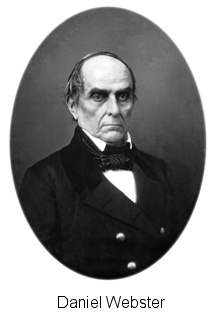 This building was renamed the "Jerry Rescue Building" in the
1850s to commemorate one of the most important events in the early life of
Syracuse. In their chapter covering "Buildings of Historical Interest," the authors of
This building was renamed the "Jerry Rescue Building" in the
1850s to commemorate one of the most important events in the early life of
Syracuse. In their chapter covering "Buildings of Historical Interest," the authors of
